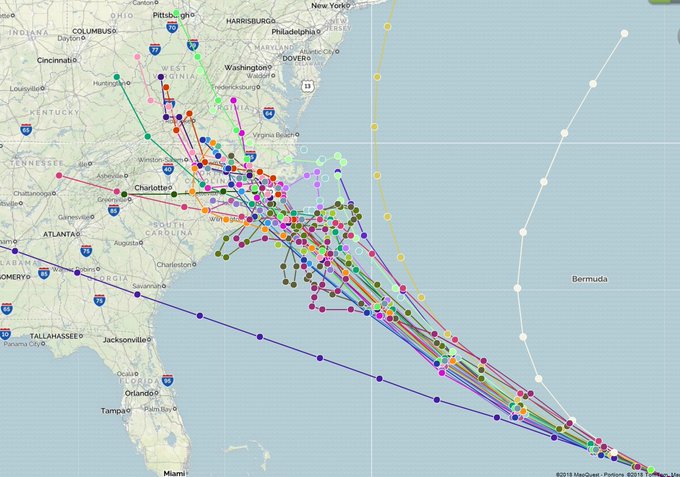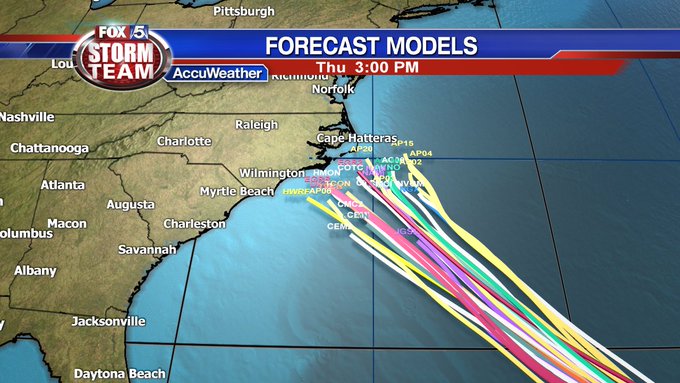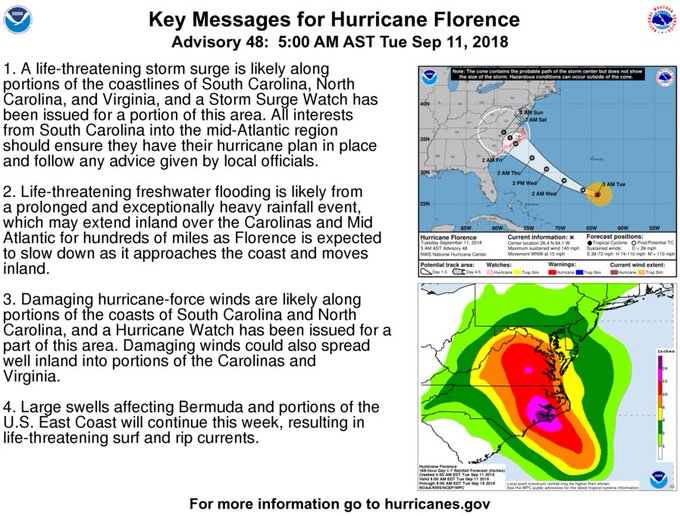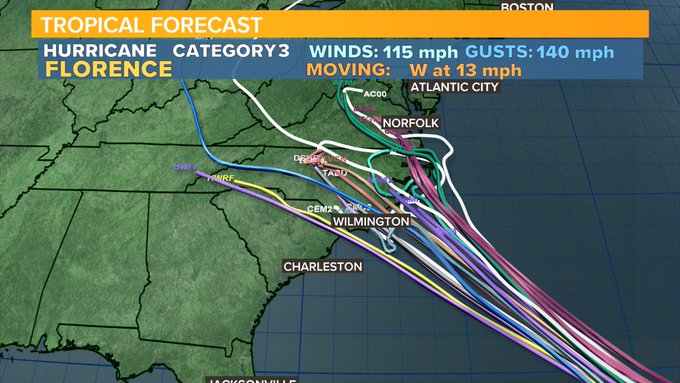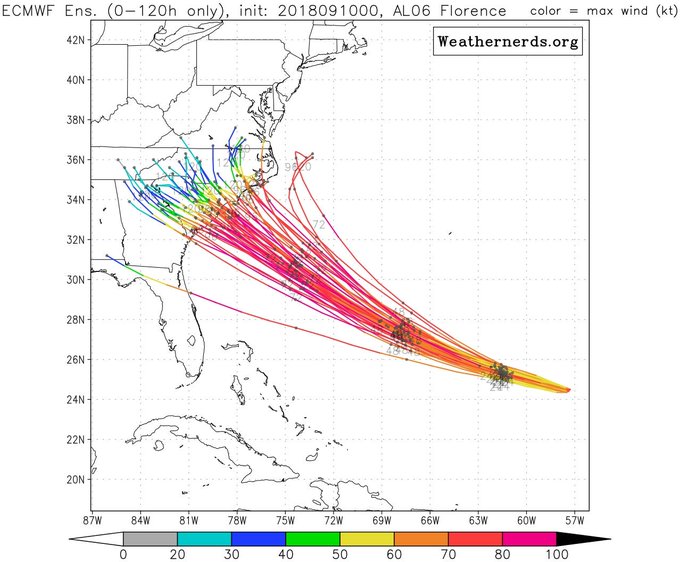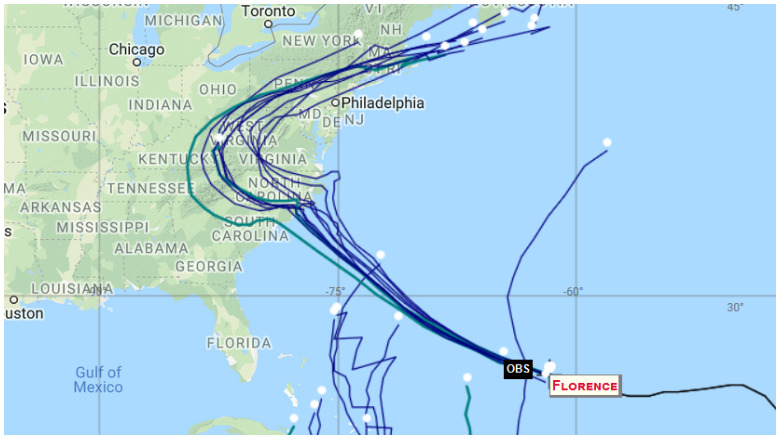
NOAA Latest Hurricane Florence spaghetti models.
As Hurricane Florence headed toward the South and North Carolina coasts, many people are worried about the storm’s exact path. Spaghetti models provide some of the most interesting visual representations of the storm’s changing track, although it’s important to remember they are only projections.
Here are some of the latest spaghetti model plots as of September 11, 2018 for Hurricane Florence. The latest tracks show the storm headed more toward North Carolina and Virginia than South Carolina.

Hurricane Florence spaghetti model
Meteorologist Chris Suchan noted that spaghetti models plots are showing clusters on the North Carolina coast, but the storm still remains somewhat unpredictable.
Spaghetti model plots were all showing a similar track. Here’s another one.
The models were all showing the storm headed for North Carolina.
Here are some sites that have constantly updated spaghetti models for Hurricane Florence:
Cyclocane
Cyclocane is one of the best sites that has constantly updated Hurricane Florence spaghetti models. You can access that site’s spaghetti models here. As of the early morning of September 11, 2018, the Cyclocane spaghetti model showed the hurricane making landfall in North Carolina.
The Cyclocane Hurricane Florence page contains other useful information, such as radar loops and imagery and watches and warnings.
NOAA
NOAA is also a good site to check for constantly updated spaghetti models. You can access the page here. The drop-down menu on the site allows you to narrow the spaghetti model maps by storm.
The NOAA spaghetti models for Hurricane Florence also show the storm turning north and threatening North Carolina and Virginia more than South Carolina at the moment. NOAA stands for the The National Oceanic and Atmospheric Administration.
Other Spaghetti Models
The South Florida Water Management District has a page of updated spaghetti models for hurricanes, including Florence. You can access it here.
Choose “storm 6” on the site to see Hurricane Florence plots.
National Weather Service
You can access the National Weather Service’s Hurricane Florence page here.
NWS released this alert on the morning of September 11, 2018:
HURRICANE FLORENCE FORECAST/ADVISORY NUMBER 48
NWS NATIONAL HURRICANE CENTER MIAMI FL AL062018
0900 UTC TUE SEP 11 2018CHANGES IN WATCHES AND WARNINGS WITH THIS ADVISORY…
A STORM SURGE WATCH HAS BEEN ISSUED FOR THE EAST COAST OF THE
UNITED STATES FROM EDISTO BEACH…SOUTH CAROLINA NORTHWARD TO
THE NORTH CAROLINA-VIRGINIA BORDER…INCLUDING THE PAMLICO AND
ALBEMARLE SOUNDS.A HURRICANE WATCH HAS BEEN ISSUED FOR THE EAST COAST OF THE UNITED
STATES FROM EDISTO BEACH… SOUTH CAROLINA… NORTHWARD TO THE
NORTH CAROLINA-VIRGINIA BORDER… INCLUDING THE PAMLICO AND
ALBEMARLE SOUNDS.SUMMARY OF WATCHES AND WARNINGS IN EFFECT…
A STORM SURGE WATCH IS IN EFFECT FOR…
* EDISTO BEACH SOUTH CAROLINA TO THE NORTH CAROLINA-VIRGINIA BORDER
* ALBEMARLE AND PAMLICO SOUNDS…INCLUDING THE NEUSE AND PAMLICO RIVERSA HURRICANE WATCH IS IN EFFECT FOR…
* EDISTO BEACH SOUTH CAROLINA TO THE NORTH CAROLINA-VIRGINIA BORDER
* ALBEMARLE AND PAMLICO SOUNDSINTERESTS ELSEWHERE IN THE SOUTHEASTERN AND MID-ATLANTIC STATES
SHOULD MONITOR THE PROGRESS OF FLORENCE. ADDITIONAL WATCHES MAY BE
REQUIRED LATER TODAY.A STORM SURGE WATCH MEANS THERE IS A POSSIBILITY OF LIFE-
THREATENING INUNDATION… FROM RISING WATER MOVING INLAND FROM THE
COASTLINE… IN THE INDICATED LOCATIONS DURING THE NEXT 48 HOURS.
FOR A DEPICTION OF AREAS AT RISK… PLEASE SEE THE NATIONAL WEATHER
SERVICE STORM SURGE WATCH/WARNING GRAPHIC… AVAILABLE AT HURRICANES.GOV.A HURRICANE WATCH MEANS THAT HURRICANE CONDITIONS ARE POSSIBLE
WITHIN THE WATCH AREA. A WATCH IS TYPICALLY ISSUED 48 HOURS
BEFORE THE ANTICIPATED FIRST OCCURRENCE OF TROPICAL-STORM-FORCE
WINDS… CONDITIONS THAT MAKE OUTSIDE PREPARATIONS DIFFICULT OR DANGEROUS.HURRICANE CENTER LOCATED NEAR 26.4N 64.1W AT 11/0900Z
POSITION ACCURATE WITHIN 15 NMPRESENT MOVEMENT TOWARD THE WEST-NORTHWEST OR 290 DEGREES AT 13 KT
ESTIMATED MINIMUM CENTRAL PRESSURE 944 MB
EYE DIAMETER 15 NM
MAX SUSTAINED WINDS 120 KT WITH GUSTS TO 145 KT.
64 KT……. 35NE 25SE 25SW 30NW.
50 KT……. 60NE 50SE 40SW 60NW.
34 KT…….130NE 130SE 80SW 110NW.
12 FT SEAS..240NE 150SE 120SW 180NW.
WINDS AND SEAS VARY GREATLY IN EACH QUADRANT. RADII IN NAUTICAL
MILES ARE THE LARGEST RADII EXPECTED ANYWHERE IN THAT QUADRANT.REPEAT…CENTER LOCATED NEAR 26.4N 64.1W AT 11/0900Z
AT 11/0600Z CENTER WAS LOCATED NEAR 26.1N 63.3W
Just before midnight on September 10, 2018, the National Weather Service reported the following:
“The rapid intensification of Florence ended just after the last advisory, with the central pressure falling to near 939 mb.Since that time, the eyewall convection has become a bit ragged and the latest central pressure from the Air Force Reserve Hurricane Hunter aircraft is near 944 mb. The initial intensity will remain a possibly generous 120 kt for this advisory based on the aircraft winds. Microwave imagery suggests that Florence may be starting an eyewall replacement cycle. However, the winds from the Hurricane Hunter did not clearly indicate the presence of an outer eyewall.”
Florence should remain “in a light shear environment and over sea surface temperatures near 29C for at least the next 48 h,” the service says.”Thus, there is little other than eyewall replacement cycles to keep the hurricane from intensifying further as indicated by all of the intensity guidance. The new intensity forecast calls for continued strengthening to near category 5 strength, although at a slower rate than what occurred during the last 30 h. Florence is expected to encounter southwesterly shear near the 72 h point, which could cause slight weakening before landfall. However, there remains high confidence that Florence will be a large and extremely dangerous hurricane, regardless of its exact intensity.”
Continues the alert: “A building mid-level ridge over the northwestern Atlantic is expected to steer Florence west-northwestward to northwestward with an increase in forward speed during the next 48 h. After that time, a marked decrease in forward speed is likely as another ridge builds over the Great Lakes to the north of Florence. The track guidance continues to show some spread between the ECMWF on the left side of the envelope and the GFS on the right side. Overall, though, the guidance has again shifted a little to the right, and the 72-96 h points are nudged just a little to the right from the previous forecast. It is important not to focus on the exact forecast track as average NHC errors at days 3, 4, and 5 are about 100, 140 and 180 n mi, respectively, and dangerous hazards will extend well away from the center.”
The National Weather Service offered these key messages:
Key Messages:
1. A life-threatening storm surge is likely along portions of the
coastlines of South Carolina, North Carolina, and Virginia, and
a Storm Surge Watch will likely be issued for some of these areas by
Tuesday morning. All interests from South Carolina into the mid-
Atlantic region should ensure they have their hurricane plan in
place and follow any advice given by local officials.2. Life-threatening freshwater flooding is likely from a prolonged
and exceptionally heavy rainfall event, which may extend inland over
the Carolinas and Mid Atlantic for hundreds of miles as Florence is
expected to slow down as it approaches the coast and moves inland.3. Damaging hurricane-force winds are likely along portions of the
coasts of South Carolina and North Carolina, and a Hurricane Watch
will likely be issued by Tuesday morning. Damaging winds could also
spread well inland into portions of the Carolinas and Virginia.4. Large swells affecting Bermuda and portions of the U.S. East
Coast will continue this week, resulting in life-threatening surf
and rip currents.

